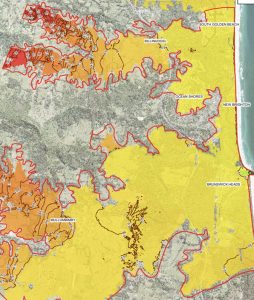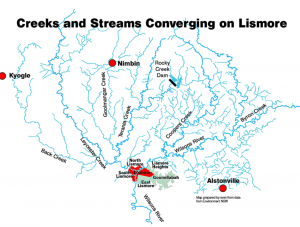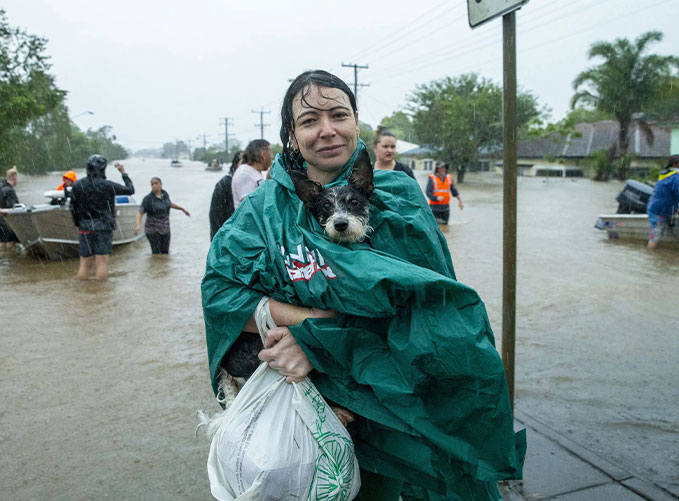Six months ago, our region suffered an ‘Inland Tsunami’. On February 27-28, 240 gigalitres of water cascaded through Lismore. This is similar to the quantity of water that flows over Niagara Falls most days. There is no known man-made dam or diversion that is going to be able to contain that.
The size and severity of the flood have left governments and NGOs reeling and looking lost. No one feels like they have a handle on the situation. The consensus is the only people who came out of the disaster deserving praise and appreciation are the volunteer first-responders who initiated the rescues while ignoring the authorities’ request to stand down.
Emergency Housing
Six months later, the instinctive human reaction to automatically act and help each other is looking frayed. The plan to house the flood victims in temporary pods is up against strong resistance from neighbourhoods saying ‘Not in my back yard please!’. Hepburn Park in Lismore was cancelled as a chosen location for housing pods. Prince Street in Mullumbimby, known as the Woolworths site, has been met with protests and demos from the neighbours.
A Plethora of Entities
Last month, the long-awaited 2022 NSW Flood Recovery Report was delivered. It includes 28 recommendations for how the state government’s disaster management should be run. The concern is the report is comprehensive and capable but does not deliver immediate practical solutions for those displaced.
The report suggests the dismantling of Resilience NSW for a “more agile” agency named Recovery NSW. The authors estimate the transition from Resilience NSW to Recovery NSW will take 12 months. A separate agency called the Reconstruction Agency (NSWRA) will focus on long-term goals such as prevention and the rebuilding of infrastructure. The agency model proposed is based on the Queensland Reconstruction Agency, which has been successfully operating since 2011.
Another layer of admin is our local entity for the Northern Rivers, the NRRC (Northern Rivers Reconstruction Corporation). This body is led by high-ranking public servant and engineer David Witherdin. Like the NSWRA, they will “have a long-term remit for the reconstruction of flood-hit communities in the Northern Rivers, which will continue beyond the immediate response and recovery phase”.
And then on top of all these local and state bodies, we have the NRRA, National Recovery and Reconstruction Agency. This is the Federal government’s board to provide funds and coordinate all the different bodies involved in this admin overabundance. The problem looks like we are just moving the deck chairs and creating alternative layers of bureaucracy with different acronyms.
Flood Recovery Report
Unfortunately, the Flood Recovery Report and the presentation of it by the premier failed to deliver what most flood victims needed to hear. They want to know about land swaps, buybacks and whether to rebuild. Commercial landlords want to know whether the town centre in Lismore is staying or moving and whether they are also in line for compensation. Everything remains in limbo until these decisions are made.
Land Lottery
In the latest announcement, the NRRC released last week a proposal for a Resilient Land Program. This is a call for private landowners to submit an EOI (Expression of Interest) to have their property assessed for viability to be used for housing. Property owners with more than 2 ha of suitable land in any of the seven Northern Rivers shires are invited to participate. This is a major move and an opportunity for State Government to be more proactive in providing necessary housing – not only for the flood displaced.
This is a good proposal but already there are concerns and foreseen problems. Local LGAs are saying they already know where the suitable land is and they should just go and approach the landowners directly and miss this time-consuming step of wading through many applicants. At the same time, most LGAs (Ballina excepted) do not have a laudable history of development and they should partner with the private sector. Yes, there are probity issues but the remit is to cut through red tape not to create more.
Repurpose Schools
Another proposal is to repurpose school classrooms for accommodation. The hope is to provide 450 demountable classrooms to be transformed into 250 housing units for Northern Rivers residents. The $20-million state government-funded project will provide a place for more than 900 displaced residents to live. The buildings will be ready to use for emergency housing in the next 6 months.
But tellingly, this announcement was not coupled with locations for these temporary dwellings. Providing prefab dwellings is the easy part, finding, approving, zoning and getting community acceptance of the location is the hard part.
Mullumbimby
The impact on Mullumbimby was not as bad as in Lismore and there is no debate about moving the town. However, Mullum urgently needs an Evacuation Centre above the PMF (Probable Maximum Flood). That would be the 1 in 500-year level as we retreat from the 1 in the 100-year level of the past. We also need Evacuation Routes to that centre. Finding one is/was the role of the SES. Now it may be NRRA.
Looking at the PMF extent of inundation around Mullumbimby not many options are available. The old Mullumbimby hospital site and the adjoining school farm are stand-out options, subject to crossing the river being feasible at the Jubilee Ave/Azalea St bridge. This is essential if Mullumbimby is to stay put and weather the floods of the future. A place to park cars and evacuate to is urgent as the RSL and Community Centre was under water and inaccessible at the height of the emergency. Also crucial is an analogue communication system when the internet goes down.
Flood Mapping
 Fortunately, the council has been doing long overdue, and more detailed, flood mapping. Readers who live in the north of the shire can access these maps here. The attached map is Figure 0-13 – PMF Peak Flood Levels. The yellow areas show the areas likely to go under during a 1 in a 500-year flood event. The maps are only for the north of the shire, there is no indication when they will complete the south of Tyagarah and Mullumbimby.
Fortunately, the council has been doing long overdue, and more detailed, flood mapping. Readers who live in the north of the shire can access these maps here. The attached map is Figure 0-13 – PMF Peak Flood Levels. The yellow areas show the areas likely to go under during a 1 in a 500-year flood event. The maps are only for the north of the shire, there is no indication when they will complete the south of Tyagarah and Mullumbimby.
Lismore CBD?
What to do with the Lismore CBD is a conundrum and various options are still being discussed. Lismore Mayor Steve Kreig is keen to rebuild the town. He says very few newly elected mayors have the opportunity to spend a ton of money and he is up for the challenge.
Mayor Kreig runs the La Baracca Cafe in the CBD. As a commercial tenant, he probably has a bias toward rebuilding. He likes the idea of building up: five-story buildings with two stories of car parking. Others prefer to start the move to higher ground and are looking at the golf course in East Lismore, which is around the same size. The old centre of town can then be transformed into parks, camping and leisure activities.
Christchurch NZ is a good precedent for how to recover after a natural disaster of this magnitude. This article in The Guardian outlines its journey from Rubble to Renewal. Their innovative use of stacked steel containers was an architectural sensation as a temporary office centre during the rebuild phase. Some locals with an arts and culture bent see an opportunity to use the flood-prone Lismore CBD for art studios, pop-ups and funky spaces, with flood resilience and easy ways to vacate and recover.
Both Kreig and local state member Janelle Saffin are keen to access all the funds and support offered by Premier Perottet, He has stated the reconstruction of the Northern Rivers is his #1 priority. Ballina and Tweed Shires are making moves to access the funding. BSC’s mayor Michael Lyon has met with David Witherdin and Premier Perottet but seems a lot more reticent than the others, probably due to Byron’s entrenched anti-development stance.
No Dam
This attached image should be looked at by all those still advocating for a dam to fix the flood issue. A dam may have some uses but holding back flood water in this catchment is not one of them. There are many watercourses and tributaries that run into ‘The Wok’. This is what the bowl of flat land that houses Lismore CBD is called by the locals – because it is a bowl and gets hot in summer. Damming just the Wilsons River will not solve the problem.

This article in The Monthly has a good overview of what happened in Lismore and options for the future. You will have to surrender your email address to access it.
Fine Words
The new NSWRA (NSW Reconstruction Agency) has good intentions and an encouraging manifesto. There is no doubt this is a hugely complex problem, but many in the community are tired of encouraging words and good intentions if action is not also arriving.
The mission statement of the NSWR says they …. “will have the power to cut through planning red tape to meet local recovery needs and find opportunities for long-term betterment. This will involve no-regrets decision-making to get people affected by the 2022 floods out of harm’s way for the future and will require the construction of new, affordable and attractive housing and related community and business facilities with amenity and a sense of community and place”.
This all sounds great but people’s patience will wear thin if decisions and outcomes are not found soon. Six months is a long time to wait not being informed of basic things like where you will be living or how much it will cost to live there. If all this does not work soon, it may be best to give the money to the first responders and the people in the tinnies and let them sort it out.
Related Articles
Post Flooding: Where to Give and Where to Get
Ongoing Housing Debate
The Wash Up – Who Wants to Live in a Flood Zone?

